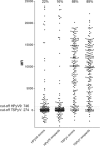Impact of HPyV9 and TSPyV coinfection on the development of BK polyomavirus viremia and associated nephropathy after kidney transplantation
- PMID: 30624811
- PMCID: PMC6590353
- DOI: 10.1002/jmv.25397
Impact of HPyV9 and TSPyV coinfection on the development of BK polyomavirus viremia and associated nephropathy after kidney transplantation
Abstract
Background: BK polyomavirus (BKPyV) persistently infects the urinary tract and causes viremia and nephropathy in kidney transplantation (KTx), recipients. In a previous study, we observed an increased incidence and load of BKPyV viremia in KTx patients coinfected with human polyomavirus 9 (HPyV9). Here we sought confirmation of this observation and explored whether novel HPyVs that have been detected in urine (HPyV9 and trichodysplasia spinulosa polyomavirus [TSPyV]) potentially aggravate BKPyV infection.
Methods: A well-characterized cohort of 209 KTx donor-recipient pairs was serologically and molecularly analyzed for HPyV9 and TSPyV coinfection. These data were correlated with the occurrence of BKPyV viremia and BKPyVAN in the recipients within a year after KTx.
Results: Seropositivity for HPyV9 (19%) and TSPyV (89%) was comparable between donors and recipients and did not correlate with BKPyV viremia and BKPyVAN that developed in 25% and 3% of the recipients, respectively. Two recipients developed TSPyV viremia and none HPyV9 viremia. Modification of the predictive effect of donor BKPyV seroreactivity on recipient BKPyV viremia by HPyV9 and TSPyV was not observed.
Conclusions: Our data provide no evidence for a promoting effect of HPyV9 and TSPyV on BKPyV infection and BKPyVAN in renal allograft patients. Therefore, we do not recommend including HPyV9 and TSPyV screening in KTx patients.
Keywords: BK infection; BK polyomavirus; BKPyV-associated nephropathy; human polyomavirus 9; kidney transplantation; trichodysplasia spinulosa polyomavirus.
© 2019 The Authors. Journal of Medical Virology Published by Wiley Periodicals, Inc.
Figures
Similar articles
-
Multiplex analysis of Human Polyomavirus diversity in kidney transplant recipients with BK virus replication.J Clin Virol. 2019 Nov;120:6-11. doi: 10.1016/j.jcv.2019.08.012. Epub 2019 Aug 27. J Clin Virol. 2019. PMID: 31505316
-
Pretransplantation Donor-Recipient Pair Seroreactivity Against BK Polyomavirus Predicts Viremia and Nephropathy After Kidney Transplantation.Am J Transplant. 2017 Jan;17(1):161-172. doi: 10.1111/ajt.13880. Epub 2016 Jul 8. Am J Transplant. 2017. PMID: 27251361
-
JC and Human polyomavirus 9 after kidney transplantation: An exploratory serological cohort study.J Clin Virol. 2021 Oct;143:104944. doi: 10.1016/j.jcv.2021.104944. Epub 2021 Aug 16. J Clin Virol. 2021. PMID: 34450559
-
Human polyomavirus 9 as a potential threat in kidney transplant recipients; lessons from BKPyV.Transpl Immunol. 2023 Oct;80:101894. doi: 10.1016/j.trim.2023.101894. Epub 2023 Jul 4. Transpl Immunol. 2023. PMID: 37414266 Review.
-
Diagnostics, treatment, and immune response in BK polyomavirus infection after pediatric kidney transplantation.Pediatr Nephrol. 2020 Mar;35(3):375-382. doi: 10.1007/s00467-018-4164-3. Epub 2018 Dec 11. Pediatr Nephrol. 2020. PMID: 30539254 Review.
Cited by
-
Torque teno virus load as marker of rejection and infection in solid organ transplantation - A systematic review and meta-analysis.Rev Med Virol. 2023 Jan;33(1):e2393. doi: 10.1002/rmv.2393. Epub 2022 Sep 3. Rev Med Virol. 2023. PMID: 36056751 Free PMC article.
-
Human genes with relative synonymous codon usage analogous to that of polyomaviruses are involved in the mechanism of polyomavirus nephropathy.Front Cell Infect Microbiol. 2022 Sep 8;12:992201. doi: 10.3389/fcimb.2022.992201. eCollection 2022. Front Cell Infect Microbiol. 2022. PMID: 36159639 Free PMC article.
References
-
- Chesters PM, Heritage J, McCance DJ. Persistence of DNA sequences of BK virus and JC virus in normal human tissues and in diseased tissues. J Infect Dis. 1983;147(4):676‐684. - PubMed
-
- Boldorini R, Veggiani C, Barco D, Monga G. Kidney and urinary tract polyomavirus infection and distribution: molecular biology investigation of 10 consecutive autopsies. Arch Pathol Lab Med. 2005;129(1):69‐73. - PubMed
-
- Wunderink HF, Van Der Meijden E, Van Der Blij‐de Brouwer CS, et al. Pretransplantation donor‐recipient pair seroreactivity against BK polyomavirus predicts viremia and nephropathy after kidney transplantation. Am J Transplant. 2017;17(1):161‐172. - PubMed
Publication types
MeSH terms
Supplementary concepts
LinkOut - more resources
Full Text Sources
Medical


